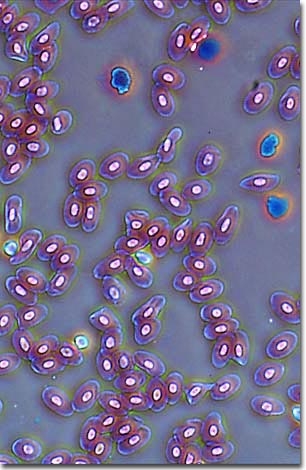Phase Contrast Image Gallery
Amphibian Red Blood Cells
Most mammalian red blood cells are highly evolved and have lost their nucleus. The nucleated red blood cells illustrated in the phase contrast optical micrograph below were derived from a frog, but are common to all amphibians.

Circulatory systems have evolved to form the most efficient oxygen transport mechanism that is possible for the organism. Oxygen is carried by hemoglobin molecules that reside within red blood cells in all advanced species. In order to maximize the distribution of blood throughout the vessels, hearts have increasingly evolved to accommodate more complex creatures. Fish hearts are relatively primitive and have only two chambers, whereas amphibian hearts are somewhat more advanced with three. The most sophisticated four-chamber hearts are found in reptiles, birds, and mammals.
Having three chambers, the amphibian heart is rather unusual in that it has two atria and only a single ventricle. This complicates matters because blood accumulates oxygen in the lungs and is then returned to the heart before being pumped into the rest of the circulatory system. A problem arises because blood returning to the heart from the lungs is mixed with incoming blood from the body, causing a mixing between oxygenated and deoxygenated blood. Amphibians deal with this situation by having a very slow metabolism, and also by absorbing some oxygen through their skin. In addition there is some directionality in controlling the distribution of blood flow by the ventricle.
The presence of a nucleus in the amphibian red blood cells allows researchers easy access to large quantities of amphibian DNA. This is also true for birds. Blood can be collected from these creatures and the red blood cells isolated by centrifugation. After removal of the residual plasma, purified cells can then be treated with specific enzymes and detergents to digest the cellular envelope and release DNA from its protein complex.
BACK TO THE PHASE CONTRAST GALLERY
